Musée national Adrien-Dubouché
Musée national Adrien-Dubouché is a French national museum dedicated to Limoges porcelain and the history of ceramics. Founded in 1845 and located in Limoges (Haute-Vienne), it is part of the Cité de la céramique - Sèvres et Limoges public establishment.
History
Founded in 1845 by Tiburce Morisot,[1] prefect of the Haute-Vienne and father of the painter Berthe Morisot, the first Limoges museum was initially housed in the prefecture's premises on Place du Présidial, and its purpose was to build up a collection: paintings, sculptures and objets d'art were collected by members of the Société archéologique et historique du Limousin.
Adrien Dubouché, the son of a cloth merchant, took on the voluntary management of the institution in 1865 and began a series of donations to add to the collections; bequests were received from French and foreign ceramics manufacturers. The city of Limoges made available a disused hospice for the insane on the Place du Champ-de-Foire: the building was converted to display the collections and house the School of Decorative Arts, founded on the initiative of Adrien Dubouché.[2]
In 1875, on the death of his friend Albert Jacquemart, author of the book Les Merveilles de la céramique, Adrien Dubouché acquired his ceramic collection, comprising 587 pieces, which he donated to the city of Limoges.[1] In recognition of this gift, and even though Adrien Dubouché was still alive, the mayor of Limoges named the museum after him.
On the eve of Dubouché's death in 1881, the museum and school were nationalised.[2] Since then, the museum has been known as the Musée National Adrien-Dubouché. The director of the Ecole Nationale Supérieure des Arts Décoratifs de Paris, Auguste Louvrier de Lajolais, was entrusted with the management of both establishments. Parisian architect Pierre-Henri Mayeux was commissioned to build the school and museum. He designed two adjoining buildings, which were inaugurated in 1900.[1]
In the 1990s, the National School of Decorative Arts in Limoges moved to the university campus.
In 2003, the Ministry of Culture and Communication launched an international competition to renovate the museum, which was won by Viennese architect Boris Podrecca and museographer Zette Cazalas.[3]
The museum was inaugurated on 28 June 2012.[4]
Collection
The Musée National Adrien Dubouché houses almost 18,000 works in ceramics (pottery, stoneware, earthenware and porcelain) and glass from various periods, from Antiquity to the present day,[1][5] and from a wide range of civilisations: ceramics from Ancient Greece and Europe, Chinese porcelain, Islamic earthenware, stoneware pieces and European porcelain from the 17th century to the present day. The museum also has a glass collection. The glass-making centres of Venice, Nevers and Bohemia are all represented. The museum also houses a public collection of Limoges porcelain.
Gallery
-
 Reception hall
Reception hall -
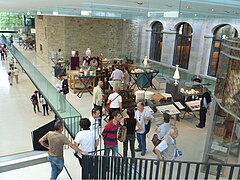 Technical mezzanine
Technical mezzanine -
 Ceramics from Antiquity to the 18th century.
Ceramics from Antiquity to the 18th century. -
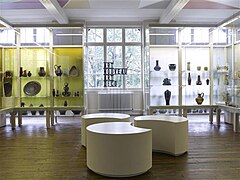 Ceramics from the 19th century to the present day.
Ceramics from the 19th century to the present day. -
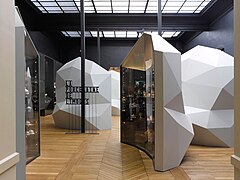 The rooms devoted to Limoges porcelain
The rooms devoted to Limoges porcelain -
 Installation by artist Zhuo Qi, 2016
Installation by artist Zhuo Qi, 2016 -
 Médaillon "Ne suis-je pas un homme, un frère ?", porcelaine tendre, Manufacture royale de Sèvres, 1789.
Médaillon "Ne suis-je pas un homme, un frère ?", porcelaine tendre, Manufacture royale de Sèvres, 1789. -
 Vase, stoneware, Manufacture Doulton et compagnie, 1878
Vase, stoneware, Manufacture Doulton et compagnie, 1878 -
 Medallion First Limousin earthenware, hard porcelain biscuit, Limoges, 1771.
Medallion First Limousin earthenware, hard porcelain biscuit, Limoges, 1771. -
 Especially the Cérès riche service, hard porcelain, Limoges, Pouyat factory, 1855.
Especially the Cérès riche service, hard porcelain, Limoges, Pouyat factory, 1855. -
 Dragonfly bowl, hard porcelain and translucent enamels, Limoges, Pouyat factory, between 1902 and 1906.
Dragonfly bowl, hard porcelain and translucent enamels, Limoges, Pouyat factory, between 1902 and 1906. -
 Mosque lamp, enamelled glass, Joseph Brocard factory, Paris, 1880.
Mosque lamp, enamelled glass, Joseph Brocard factory, Paris, 1880. -
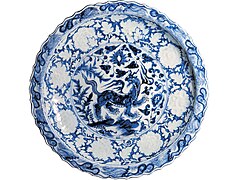 Baizi" dish, Jingdhezen kilns (China), hard porcelain, mid-14th century (Yuan dynasty).
Baizi" dish, Jingdhezen kilns (China), hard porcelain, mid-14th century (Yuan dynasty). -
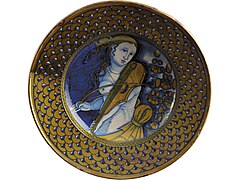 Woman with a viol dish, earthenware and metal lustre, Deruta (Italy), 16th century (on loan from the Louvre)
Woman with a viol dish, earthenware and metal lustre, Deruta (Italy), 16th century (on loan from the Louvre)
References
- ^ a b c d "Le musée Dubouché, temple de la porcelaine, célèbre le bicentenaire de son bienfaiteur". Franceinfo (in French). 2018-11-06. Retrieved 2023-10-16.
- ^ a b "Porcelaine : le musée Adrien Dubouché de Limoges fête les 200 ans de son fondateur". France 3 Nouvelle-Aquitaine (in French). 2018-06-30. Retrieved 2023-10-16.
- ^ "Musée National de la Porcelaine : Zen+dCo". zendco.com. Retrieved 2023-10-16.
- ^ "Le musée Dubouché, temple de la porcelaine, inauguré jeudi". Franceinfo (in French). 2016-12-06. Retrieved 2023-10-16.
- ^ "National Museum Adrien-Dubouché – Cité de la céramique". www.nouvelle-aquitaine-tourisme.com. Retrieved 2023-10-16.
External links
- Architecture resources: Mérimée
- Resource on public life: Appointments to the Official Journal
- Fine arts resource: Agence Photo RMN Grand Palais
- Tourism resource: Museofile

























